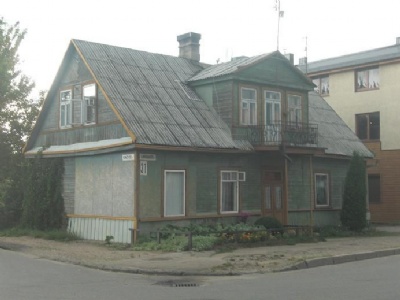Kaunas Ghetto
In 1939, there were about 40,000 Jews living in Kaunas, which corresponded about one third of the population. During the first Soviet occupation between 1940 and 1941, all Jewish institutions and organizations were closed. A week before the German invasion, large-scale deportations of Jews were carried out to Gulag camps far away in the Soviet Union. The Germans occupied Kaunas on June 24, 1941, and this triggered strong Lithuanian nationalist sentiments that culminated in pogroms against Jews in Kaunas and other Lithuanian cities. Jews were accused of being responsible for the soviet occupation and hundreds of Jews were openly murdered by Lithuanian nationalists. Thse pogroms happenede spontaneoulsy without German interference.
The most well documented pogrom took plac June 27, at Lietuki’s garage in Kaunas. More than 60 Jews were murdered with bludgeons, pipes and other kinds of weapons. The pogrom took place openly in front of passive spectators and German soldiers who photographed the massacre. The bodies were then left for public viewing and the Lithuanian national anthem was played as a kind of tribute to the pogrom. The Germans subsequently assumed control of these actions of violence but had nothing against ”spontaneous” actions against the Jews. Several Lithuanians volunteered in subsequent murderous actions against the Jews. Thousands of Jews were imprisoned and murdered in fourth, seventh and ninth fort outside Kaunas. An estimated 10,000 Jews were murdered in June and July 1941.
In August, 1941, the Nazis established a jewish ghetto in the Slobodka district (Viljampole) and isolated it from neighbouring areas with barbed wire fences. It was forbidden for the Jews to leave the ghetto, onky with special permission you were allowed to leave the ghetto. In October 1941, what came to be called the Die grosse action (The great action) began. In the next two and a half months, about 9,000 Jews, half of them children, were murdered at Kaunas ninth fort. Next 18 months passed by without any large killing actions taking place. This did not mean that life in the ghetto was pleasant, but the actions that took place were more sporadic and rare. The Jews of the ghetto were forced to work mainly in the German war industry. In mid-1943, the Nazis began liquidating the ghettos of eastern Europe. But the ghetto in Kaunas was converted to a concentration camp and was called KZ Kauen. It was considered too important for the German war industry to be liquidated.
The camp did not begin to be liquidated until July, 1944, when the Red Army approached Kaunas. For five days the camp/ghetto was emptied of Jews and the ghetto was set on fire to force out the Jews in hiding. About 3,500 Jews were murdered, but a hundred managed to escape to nearby forests where some joined partisan groups. Those who had not been murdered or fled were deported to Dachau and Stutthof. Kaunas was recaptured by Soviet forces in 1944. At that time, there were about 500 Jews left in the area who had managed to stay undetected. Another 2500 survived the war in the Nazi concentration camps.
Current status: Partly preserved/demolished with monument (2010).
Address: 2 Linkuvos gatve, Kaunas 48005.
Get there: Car.
Follow up in books: Arad, Yitzhak: Holocaust in the Soviet union (2009).



In 2010 there were still dilapidated and abandoned old wooden houses from the Second World War. Kaunas has a lot to offer for those who are interested in the Holocaust, although not very known. All focus is undoubtedly on the larger and more famous ghettos such as Warsaw and Krakow. Kaunas is a nice town and the proximity to Vilnius (about 100 kilometres) makes Kaunas a perfect city to visit where the Holocaust not yet has been commercialized.